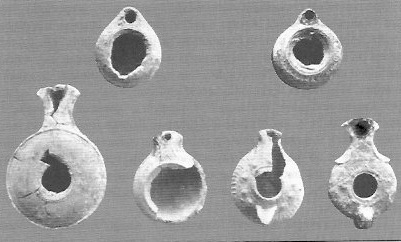|
Home
Order the book
Essential Reading on Nazareth
The Nazareth QUIZ
Comments received
Mythicist Discussion list
The movie AGORA
Submit feedback
Favorite mythicist websites
Vridar
Dr. Robert M. Price
Dr. Hermann Detering
Earl Doherty
American Atheists

|
Scandal 3
Alleged “Hellenistic” evidence
It is self-explanatory that if the village of Nazareth existed in the time of Jesus, then it had to come into existence before his birth. For the Christian tradition, then, scripture all but requires that Nazareth was already in existence in Hellenistic times, the age that preceded the Roman conquest of 63 BCE. One epoch depends on the other: the existence of a viable village at the turn of the era (one with a synagogue and crowd that could accompany Jesus, Lk 4:16-30) depends on it being in existence already in Hellenistic times.
As early as 1931, however, Catholic archaeologists themselves noted a shocking lack of evidence of a Greco-Roman settlement in the Nazareth basin (see Part Two of The Myth of Nazareth). This placed an enormous burden on the tradition to materially demonstrate the existence of Nazareth in Early Roman times, as demanded by scripture.

These six oil lamps were discovered in a Nazareth tomb, and have been used in the scholarly literature (photo from QDAP 1931, Pl. XXXIV.2) as proof of a village at Nazareth in Hellenistic times, that is, as early as the third century BCE. In fact, the six lamps date from the Middle Roman to the Late Roman periods, long after the time of Christ. The interesting story of these oil lamps (and their gross misdating) follows.
In 1930, while laying the foundations for a private house in Nazareth, a tomb was discovered 320 meters southwest of the Church of the Annunciation. As is customary in the Holy Land, work was immediately suspended and the Department of Antiquities was notified. An inspector came to the site, and subsequent excavation uncovered a rectangular underground chamber with nine shafts (kokhim) radiating outwards from three sides. The tomb was known to Bagatti (the principle Catholic archaeologist of Nazareth) as number 72. It contained human bones and some artefacts, including the six oil lamps above, a juglet, beads, and small glass vessels. These finds were summarized in a brief report published in the 1931 issue of a new journal, The Quarterly of the Department of Antiquities in Palestine. The report, entitled “A Rock-cut Tomb at Nazareth,” consists of a mere half-page of prose, followed by three pages of diagrams and photographs. It is signed “E.T.R.” (Ernest Tatham Richmond). The report itself is unremarkable except for one word in the final sentence:
Tomb No. 10. Two glass vessels (Pl XXXIII.5, third and fourth from left), six Hellenistic lamps (Pl. XXXIV.2), and iron, glass, and pottery fragments. E.T.R.
This is the first mention in the scholarly Nazareth literature of specific Hellenistic evidence. If Richmond were correct, and if six Hellenistic oil lamps were indeed found only a few hundred meters from the venerated area, then the case for Nazareth existing in the time of Jesus would be closed, and virtually assured. Such is the awesome importance of the single word “Hellenistic” in this brief and obscure report.
Are the six oil lamps Hellenistic? The answer is emphatically “no.” A glance at the photo shows to even an amateur that none of the lamps signaled by Richmond is Hellenistic. The two in the upper row have been dated by Israeli specialists to between “the second half of the first century A.D.” and the third century, that is, to Middle-Late Roman times. Two of the lamps (lower left and lower right) are of the bow-spouted (“Herodian”) type, which are dated in Galilee from c. 25 CE to c. 150 CE. The remaining two lamps are Late Roman (see below). In other words, all six oil lamps date to the common era, and some long after the time of Christ. The error in Richmond's report amounts to five or more centuries!
More precise details on dating these lamps are given in my book, The Myth of Nazareth. Using 70 CE as the beginning of Middle Roman times, all six oil lamps in the illustration are Middle Roman, Late Roman, or Early Byzantine. None is remotely Hellenistic.
One can only speculate how the word “Hellenistic” entered Richmond’s report. The discrepancy in dating is huge, amounting to between three and five centuries. No expert would be capable of such a mistake. Nor would he treat these six lamps as a group, for they represent strikingly different types. It is remarkable that this egregious error survived the scrutiny of the Department of Antiquities of Palestine, in whose Quarterly the report was published. But then, Richmond was himself Director of the Department at the time!
The six oil lamps pictured above underwent a second stage of misrepresentation a few years after the publication of Richmond’s report. Fr. Clemens Kopp penned the first installment of his extensive writings on Nazareth archaeology in 1938. He commented on Richmond’s “Hellenistic” assessment as follows:
R[ichmond] classifies 6 lamps by date very generally as “Hellenistic,” according to the accompanying photographs of the finds they must surely go back at least to 200 BCE.
This statement goes considerably beyond Richmond’s error of the single word “Hellenistic,” which denotes a period continuing into I BCE. Fr. Kopp supplies a much earlier date: “at least… 200 BCE,” i.e., the third century BCE. This magnifies the previous mistake and, again, we can only wonder what made the German priest choose a date that has not the remotest relevance to the lamps in question. Even an amateur collector would not be so misled, much less an antiquities dealer, not to mention a writer on archaeological matters such as Fr. Kopp. To date this group of Roman-Byzantine oil lamps before 200 BCE is a monstrosity. There is no question of an inadvertent slip for, as we see, Fr. Kopp claims to have examined the accompanying photographs himself, and he appeals to his own expertise. The only possible conclusion, then, is that deception is heaped upon deception.
The priest’s modus operandi is transparent. Kopp fabricates Hellenistic evidence in an attempt to bolster the case that Nazareth existed before the time of Christ. At the same time, he undergirds the Church’s position by providing a false Hellenistic claim, one now available for subsequent citation in the Nazareth literature.
The story does not end here. In the 1960s Fr. Bagatti acknowledged Richmond and Kopp’s error and correctly redates the lamps to II-III CE. However, having removed one problem, the Catholic archaeologist then substituted another which is equally inappropriate:
Tomb No 72 (fig. 3 D1). In this place there are several kokhim tombs, but the plan of one only is given with a description of the objects, by the one time Director of Antiquities in Palestine T. Richmond. It had lamps, which are round and have a concavity; they were in use in 2nd-3rd cent.; a glass pendant with a lion and according to Richmond other “Herodian” objects. (Exc. 242)
Bagatti does not mention the word “Hellenistic,” and his dating “2nd-3rd cent.” can only mean “CE” (an interesting omission, for the four centuries between II BCE and III CE are precisely the issue at stake). The archaeologist’s quaint terminology—“lamps, which are round and have a concavity”—is his customary euphemism for a common Roman lamp type. (Typical mould-made lamps of Middle-Late Roman times are round and have a concavity or depressed area towards the center of the discus.) But we are most interested in Fr. Bagatti's final phrase: “according to Richmond there were other ‘Herodian’ objects.” Of course, Richmond did not use the word “Herodian.”in his report. This was purely Bagatti's invention. The Italian priest has essentially substituted the word “Hellenistic” with “Herodian.” If he could not defend the one, then he would use the other. Both support the Church’s position, and both are equally incorrect in relation to these oil lamps.
It should be noted that “Hellenistic” and “Herodian” are highly-charged terms when associated with the archaeology of early Christianity. They are prized by the tradition, for both these terms support the orthodox view that a settlement at Nazareth existed in the time of Christ. “Herodian” is a misnomer. Lamps known by that name (more correctly called bow-spouted lamps) were used in the Galilee between c. 25 CE and c. 150 CE. This is after the time of Herod the Great, and even too late for the time of Jesus. It effectively removes these lamps (which are the earliest datable Roman artefacts at Nazareth) from evidence for a village at the turn of the era.
So it is that the tradition has completely confused Nazareth archaeology by inappropriately using terms like “Hellenistic”and “Herodian” in relation to artefacts which are in fact Middle and Late Roman.
The oil lamp evidence alone clearly shows that Nazareth did not yet exist in the time of Jesus.
—René Salm
Updated June 30, 2014
|
Scandal sheets
Coverups relating to Nazareth archaeology.
Scandal 1
Hidden tombs under the house of Mary
(the Church of the Annunciation)
Scandal 2
The shell game with Nazareth evidence
Scandal 4
“Herodian” and the misdating of Nazareth evidence
Scandal 5
The Nazareth Village Farm Report
Scandal 6
A ‘House from the time of Jesus’?
Scandal 7
“Israel’s Evangelical Approach” and Nazareth
Scandal 8
The Nazareth coin boondoggle
Scandal 9
The 1962 forgery of the “Caesarea inscription”
Scandal 10
Nazareth archaeology leads to peer review breakdown
Fact or faith?
Check your knowledge with
THE NAZARETH QUIZ
It's interactive, fun, and educational!
Click on the link at upper left.

|